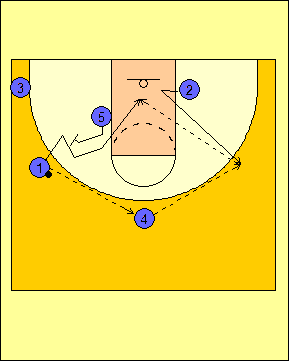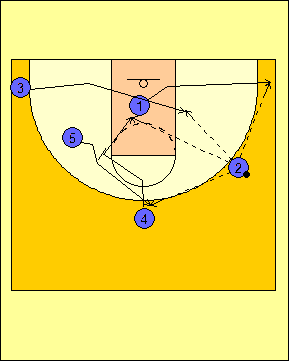|

Basketball Coaching DVD's at Championship Productions
SHUFFLE OFFENSE
Coaches ranging from Bruce Drake to Bob Speer have found extensive success
thanks to the Shuffle Offense. These coaches were capable of winning a
good number of games against teams with more talent and more size. Thanks
to the Shuffle Offense, teams that were coached by the two had amazing success
despite all of their shortcomings.
Advantages of the Shuffle Offense
There are a number of advantages that the Shuffle Offense presents to coaches
when they use it. The first of these is that the Shuffle Offense sets up
high percentage shots thanks to the movement of the offense. The offense
allows for a feed to a cutter off of a down screen for a lay-up or a flash from
the help side for a post-up.
Second, the Shuffle Offense's basic movement can be used as an entry into other
offenses. Teams have used the Shuffle Offense's movements to set up
offenses such as motion and pinch post offenses. Running just the basic
cut allows for a quick scoring option or a great way to set up the offense that
can be run off of the basic cut.
Finally, the Shuffle Offense forces the defense to guard several maneuvers that
provide the offense with several options. Because the movements are made
quickly, the defense has to react to them at the tempo of the offense which
gives the offense an advantage. Whenever a team has the basketball, if
they can control the tempo, they will have the opportunity to get good shots and
great movement.
Disadvantages of the Shuffle Offense
There are two main disadvantages of the Shuffle Offense.
The first of these is that since the Shuffle Offense is a patterned
offense, it can be easily scouted. It can also be countered by the
defense. To prepare for this, you will need to have a series of
counters ready for anything the defense throws at your team. Those
counters will be presented later in the article.
The second of these is that since the Shuffle Offense
requires all five players to play all five positions, all five players
must be capable of making cuts off of screens, shooting from the
perimeter, and posting up in the mid post. If you have one player
who cannot handle the ball on the perimeter, you can hide him by running
a four-man version of the offense which will be presented later on in
this article. However, if you intend to run the full five-man
version of the Shuffle Offense, you must have five players who can play
all five positions.
Basic Movement
In the Shuffle Offense, there are five basic positions: the cutter, the corner,
the post, the point, and the feeder. All five of these positions run in a
particular continuity so that all five players play all five of the positions.
Here is a table describing the flow assuming that the offense is run without any
interruptions in the Shuffle Offense continuality.
| Starting Position |
Offensive Continuity |
| Cutter |
Cutter→Corner→Post→Point→Feeder |
| Corner |
Corner→Post→Point→Feeder→Cutter |
| Post |
Post→Point→Feeder→Cutter→Corner |
| Point |
Point→Feeder→Cutter→Corner→Post |
| Feeder |
Feeder→Cutter→Corner→Post→Point |
In Diagram 1, the Shuffle Offense starts with #1 as the cutter, #2 as the
feeder, #3 as the corner, #4 as the point, and #5 as the post. The action
begins with the cutter passing to the point who then passes to the feeder as he
pops out from the short corner opposite the cutter to the wing on his side.
When the feeder receives the ball, he will pass to the cutter coming off of a
back screen set by the
The action continues in Diagram 2 with the cutter clearing to the ball-side
corner. Once the cutter clears, the corner will flash to the ball-side mid
post and the point sets a down screen for the post.

Diagram
1 |

Diagram
2 |
If the ball is reversed and the it cannot be entered to
either the cutter or to the post, we will look to swing the ball again.
In Diagram 3, the cutter (#2) will pass to the point (#5) who will then
pass to the feeder (#4). The cutter (#2) will come off of the back
screen set by the post (#3).
The action then leads into Diagram 4 with the corner
(#1) flashing to the ball-side mid post once the cutter clears.
Once again, the point will set a down screen for the post with the
possibility of the continuality action starting all over again.

© 2010-2017 Alan Peel Enterprises
|